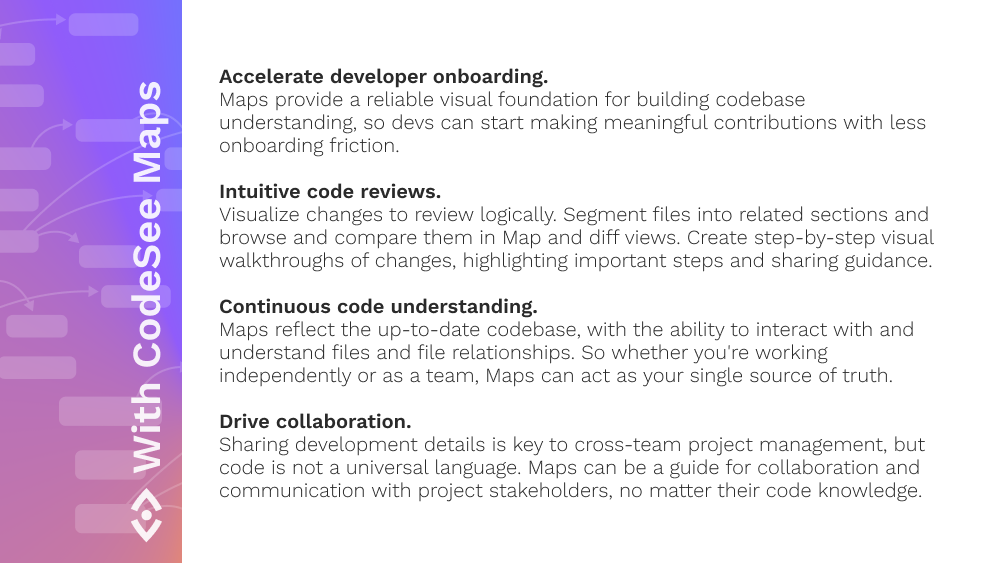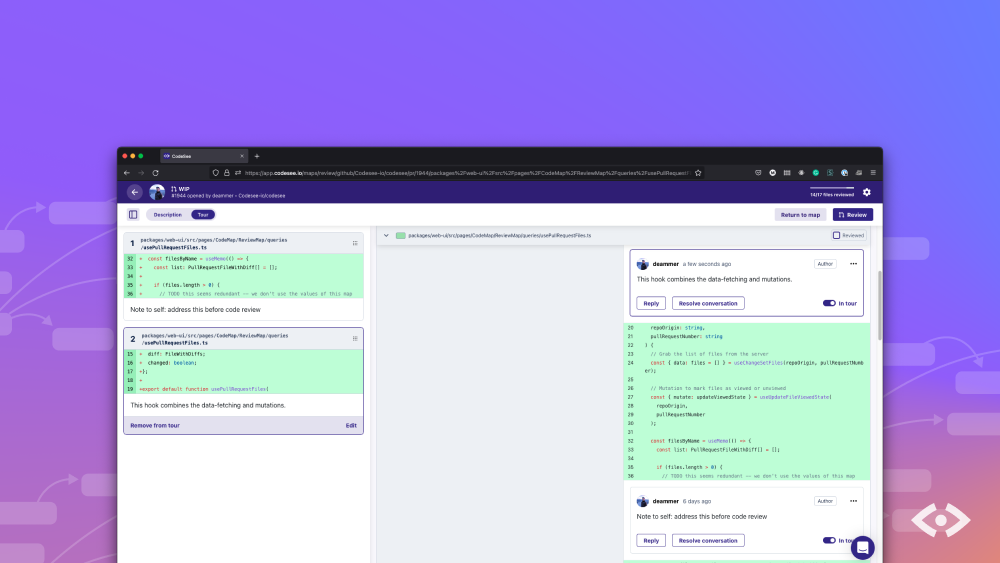Console
Working at CodeSee
CodeSee is a developer tool that visualizes how your code works for codebase onboarding, planning, and code reviews.
Tech stack
TypescriptNodeAWSPostgres
How engineering works at CodeSee
How are the teams structured?
Today, we have one engineering team made up of a combination of principal frontend, backend, and full stack engineers. As we continue to hire, will we break up into 2+ teams, with each (as much as possible) focused on their own areas of ownership.
What tools do engineers use?
- Design: Figma
- Source control: Git & GitHub
- Issue tracking: Linear
- Documentation: Coda
- Incident management: DataDog, PagerDuty
- Internal communication: Slack
- External communication: Discord, Slack, blog, intercom
- Builds & deploys: GitHub Actions
- Error tracking: Sentry
- Monitoring, traces, logging: Datadog
Can developers pick their own tools?
We have a general policy of developers picking the tools that they work with on a daily basis e.g. their code editor, and we pay for team licenses for common tools like IDEs. We try to standardize on the above list in production, but are open to projects trying new tools alongside them. There have been several cases where a teammate has adopted something themselves which has then been rolled out across the company.
How does the development process work? What's the process for working through bugs, features and tech debt?
We talk to our users with user interviews, feedback sessions and demos. The backlog is balanced between requests from users, future vision stuff, infrastructure, and tech debt. We work on weekly sprints with design and product being about 2-3 weeks ahead so things move very quickly. The engineering team lead runs sprint planning and breaks down the work into tickets alongside the engineers. As the project nears completion, product reviews and devrel marketing (if needed) become involved. The product manager has the final say on go/no go but we are constantly deploying small incremental changes. This results in 1-5 deploys a day.
How does code get reviewed, merged, and deployed?
All development is done in branches against our monorepo. We encourage small PRs, with regular rebasing from main. Some of the team do pair programming, but it is not mandatory. We do have a very collaborative development team, and work hard to prevent people being siloed. When the engineer is happy with their branch, they open a pull request. CI runs. At least one other engineer will review the code and then it will be merged into main. We have good test coverage and automated builds. With feature flags we can roll new code out gradually to our cloud users. We do single click push button deploys meaning we deploy multiple times a day.
What is the QA process?
We try to write good automated tests. The Eng and product team test new features and we do group bug bashes!
What are some recent examples of interesting development challenges solved by internal teams as part of building the product?
We built real-time collaborative editing of our diagrams (think Figma) by developing a websocket-based server that uses CRDTs and a zero-downtime deployment using our own leader election implementation. This is a strong foundation that we will be improving and building on top of for some time.
We are visualizing code and code changes in ways that have never been done before, and making those visualizations interactive. This requires innovation and iteration from everyone from the designer to the frontend engineers.
We are parsing code in a (growing) number of different languages in order to do code analysis, and existing tools rarely do precisely what we want. This creates challenges around tweaking existing libraries (and contributing back) or building new ones. Then testing and deploying those polyglot libraries as part of our workers.
How does on-call work?
Teams are incentivized to minimize in-production errors and alerts because they are the ones on-call for their own systems. Teams are right-sized to ensure there is always coverage, with slack for holidays, illness, and taking time off the next day if you are paged out of hours. Everyone should expect to do a 2 week on-call rotation every 8 weeks (one week you are the primary and the second week you are the secondary). Any big incidents we pull in other members of the team to support one another.
Hiring process at CodeSee
How does the application process work? What are the stages and what is the timeline?
We have a multi-step process:
- Initial phone/zoom screen with our Head of People.
- 2 hour - pairing session on a coding problem. You can use any environment you want, any language you want. You can look things up and use libraries. This discussion is really meant to as closely as possible simulate a real day on the job.
- 2 hour - System Design discussion. We’ll talk through a project that you’ve spent a lot of time on, your methods and thought processes.
- 2 Hour - Top Grade: A top grade is an interview to understand you, your motivations and how you would be as an employee. We all are human beings.
- Offer.
We aim to get through the whole process within 2 weeks, but can go much faster if necessary and the candidate's schedule permits.
About Console
Console is the place developers go to find the best tools. Each week, our weekly newsletter picks out the most interesting tools and new releases. We keep track of everything - dev tools, devops, cloud, and APIs - so you don't have to.
Subscribe to the weekly Console newsletter
An email digest of the best tools and beta releases for developers. Every Thursday. See the latest email


